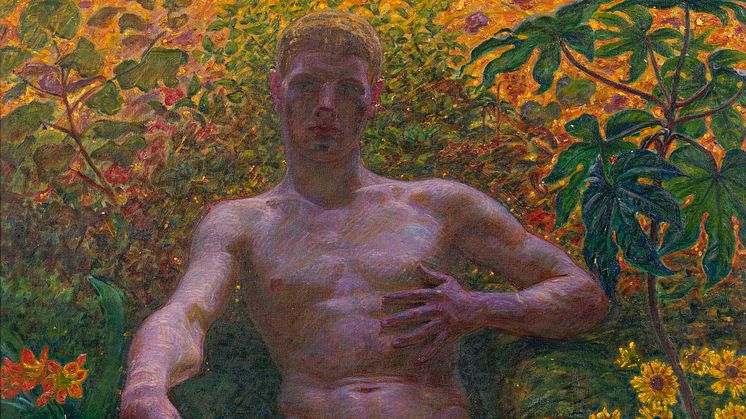
Press release -
New acquisition: Adam in Paradise by Kristian Zahrtmann
Nationalmuseum has acquired the painting Adam in Paradise by the Danish artist Kristian Zahrtmann. It is one of a group of erotic depictions of men which were perceived at the time as being too provocative and ended up in private collections where they have been out of sight for the general public. Thanks to the acquisition, the painting will be one of only a few to be given a permanent place in public.
The painting by Kristian Zahrtmann (1843-1917) was produced in 1914. It portrays Adam on his own, surrounded by the fruits and flowers of the Garden of Eden. The motif is essentially biblical but at the same time clearly erotic. When the painting was exhibited in 1914 at Den Frie Udstilling in Copenhagen, it was met with scathing criticism and was regarded as being too provocative and unconventional to be purchased for state collections.
”I think even now Adam in Paradise is a painting that can still challenge our conceptions of taste and conventions. At the time, the painting was regarded as unacceptable by society, in part because of the flamboyant colours and the nudity but perhaps even more so because the artist painted the model with a bored expression instead of letting him play the role of biblical Adam with passion. It is very obvious that he is a potential object for the viewer’s lust, rather than being part of a moral story. The painting can therefore be regarded as one the boldest works of Danish art from that time and also the most interesting, not least from a queer perspective,” says Carl-Johan Olsson, curator 19th century art at Nationalmuseum.
In many ways, Zahrtmann is an oddity in the history of art. He became successful as a painter of history but he went his own way early on by frequently choosing to paint historically prominent women in scenes that were modified in different ways – often with humour and a touch of decadence. During the 1880s, he became an important person on Denmark’s art scene as a teacher at Kunstnernes Frie Studieskoler which was an alternative to Kunstakademiet. He continued in that role into the 20th century and thereby was of great significance for the development of modern art in Denmark.
Of late, Zahrtmann has been very much in focus because of his free views regarding gender roles and sexuality and how they are reflected in his art. An exhibition with this theme is currently on tour in Denmark, visiting Ribe Kunstmuseum, Fuglsang Kunstmuseum and Den Hitschsprungske Samling.
Nationalmuseum receives no state funds with which to acquire design, applied art and artwork; instead the collections are enriched through donations and gifts from private foundations and trusts. The acquisition has been made possible by a donation from Nationalmusei Vänner.
Inventory number:
Kristian Zahrtmann, Adam in Paradise, 1914. Oil on canvas. NM 7531.
For more information
Carl-Johan Olsson, curator 19th century art, carl-johan.olsson@nationalmuseum.se, +46 (0)8 5195 4324
Hanna Tottmar, head of press, press@nationalmuseum.se, +46 (0)8 5195 4400
Categories
Nationalmuseum is Sweden’s museum of art and design. The collections comprise older paintings, sculpture, drawings and graphic art, and applied art and design up to the present day. The museum building has currently been renovated and reopened in autumn 2018. Nationalmuseum has partnerships with Svenska Dagbladet, Bank of America Merrill Lynch, The Wineagency and the Grand Hôtel Stockholm.

